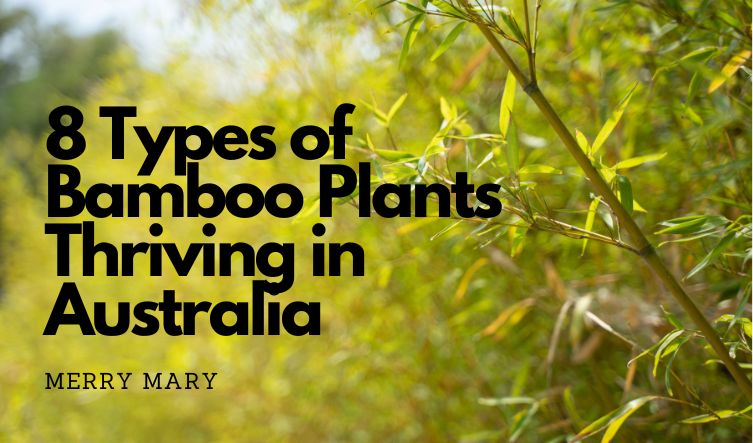Types of Bamboo Plants – Are you ready to turn your backyard into a tropical paradise? Let me introduce you to the magical world of bamboo! This fast-growing and versatile plant has everything you need to create a stunning oasis in your own backyard. With its lush foliage and exotic elegance, bamboo is the perfect addition to any Australian garden. Get ready to be amazed by the endless possibilities – from creating lush privacy screens to stunning ornamental features, bamboo is sure to add a touch of excitement and uniqueness to your landscape.
But before diving headfirst into the world of bamboo, it’s important to understand the types available and which will thrive in Australia’s diverse climate. This comprehensive guide will unveil the secrets to cultivating a flourishing bamboo paradise in your own backyard!
Understanding Bamboo: Clumping vs. Running
Overall, there are two main types of bamboo: clumping and running. Clumping bamboos grow in dense clumps and are generally low-maintenance. Running bamboos, on the other hand, spread rapidly through underground rhizomes and can become invasive if not managed properly.
When choosing a bamboo for your garden, it’s crucial to select a clumping variety to avoid unwanted spreading.
Clumping Bamboo: The Low-Maintenance Choice
Are you an enthusiastic gardener from Australia looking to add a dash of sophistication to your outdoor area but don’t want the added burden of regular maintenance? If yes, then clumping bamboos could be the ideal choice for you! These bamboos are a perfect combination of beauty and functionality, making them an excellent addition to your garden. Want to know more about why clumping bamboos are so popular among gardeners in Australia? Read on!
- Limited Spread: Unlike their other types of bamboo counterparts, clumping bamboos grow in dense clumps and don’t aggressively spread underground. This means you won’t have to worry about them taking over your garden or popping up in unexpected places.
- Easy to Manage: Since they grow in contained clumps, clumping bamboos require minimal maintenance. You won’t need to spend time or effort digging up and removing unwanted shoots, a common battle with running bamboos.
- Low Risk of Invasiveness: Running bamboo can grow invasive if not adequately maintained. With clumping variants, this risk is considerably decreased. They will remain in their appropriate location, providing beauty to your yard without posing a future problem.
- Generally Lower Maintenance Needs: In terms of overall care, clumping bamboos tend to be less demanding. They typically require regular watering, especially during dry spells, but don’t need constant attention when it comes to pruning or controlling their spread.
- Perfect for Smaller Gardens: Due to their limited spread, clumping bamboos are ideal for smaller gardens or even pots. This allows you to enjoy the beauty of bamboo even if you have limited space.
In essence, clumping bamboos offer all the aesthetic appeal of bamboo with significantly less maintenance and a lower risk of becoming invasive. They’re a fantastic choice for busy gardeners or those who want a hassle-free way to add a touch of Zen to their Australian oasis.
Here are some popular varieties that flourish in the Australian climate:
Bambusa Multiplex (Golden Bamboo)
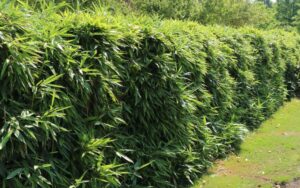
This types of bamboo also known as fishpole bambo, with its vibrant golden culms (stems), boasts Asian origins and has adapted well to Australian soil.
It thrives in well-drained, fertile soil with moderate watering and prefers a position with dappled sunlight. New South Wales, Queensland, and Victoria offer ideal climates for Golden Bamboo to grow.
Bambusa Textilis (Weaving Bamboo)
Bamboo, a versatile plant, has a rich history of use in textile production. It has now found a new home in Australia, where it is cherished and cultivated. Textiles, a specific variety of bamboo, thrive in well-drained soil and require regular watering during dry spells. It can tolerate full sun to partial shade and flourishes in the warm and humid climates of New South Wales, Queensland, Victoria, and even Tasmania. Its adaptability and durability make it a great choice for gardeners and landscapers alike.
Fargesia Robusta (Fountain Bamboo)
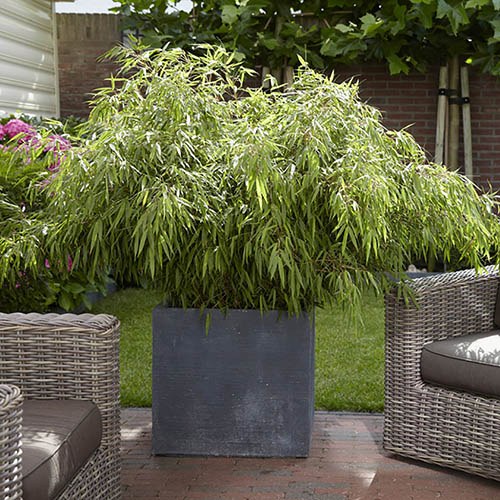
Fargesia Robusta, a stunning bamboo species originally from China, has gained popularity among gardeners for its elegant and flowing appearance. This low-maintenance plant is easy to care for and flourishes in well-drained, moist soil. It prefers a location that receives filtered sunlight or light shade.
Fargesia Robusta can grow in all Australian states because it’s highly adaptable except for arid regions, making it an excellent choice for a wide range of garden styles and environments.
Running Bamboo: A Touch More Care Required
Bamboos have a unique allure that is hard to resist. The sight of these tall, slender plants, with their lush green leaves and rapid growth, is enchanting. They have the unique ability to form dense hedges or dramatic groves, which can add an exotic touch to any landscape. However, it’s important to note that the running bamboos require more attention and maintenance compared to their clumping counterparts. It’s crucial to understand their growth patterns and take necessary measures to prevent their spread, or they can quickly take over your yard or garden.
Here’s why running bamboos require a touch more care:
- Aggressive Spread: The defining characteristic of running bamboos is their extensive underground network of rhizomes (rootstalks) that can travel significant distances. Left unchecked, they can easily take over your garden and even encroach on your neighbor’s property.
- Management is Key: To harness the beauty of running bamboos without them becoming a future headache, you’ll need to implement management strategies. This might involve installing a root barrier around the planting area to physically restrict their spread. Additionally, regular monitoring and removal of any unwanted shoots that pop up beyond the designated area is crucial.
- More Frequent Watering: Running bamboos tend to have higher water needs compared to clumping varieties. This is because their rapid growth and extensive root system require more consistent moisture. During hot and dry periods, be prepared to provide them with regular watering to ensure healthy growth.
- Potential for Invasiveness: If not properly managed, running bamboos can become invasive. Their aggressive spreading nature can cause problems in your garden and potentially create conflict with your neighbors. This is why choosing the right variety and implementing proper control measures is essential.
While flowing bamboos require more attention, their unquestionable beauty and potential to create dramatic landscapes can be a well-deserved reward for diligent gardeners. With careful planning, good management practices, and a little additional TLC, you can grow a gorgeous display of running bamboo in your Australian garden.
Phyllostachys Aurea (Golden Bamboo)
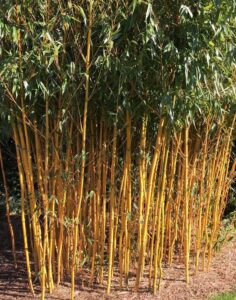
The magnificent Asian bamboo, boasting its striking golden culms, has made its way into the hearts of Australian garden enthusiasts. It delights in well-drained and nutrient-rich soil, requiring moderate watering and basking in full sun or partial shade. However, its vigorous spreading habit demands the installation of a root barrier to keep its growth under control.
Phyllostachys Aurea, commonly known as Golden Bamboo, is a species of bamboo that thrives in warm and temperate climates. It is well-suited to grow in the Australian states of New South Wales, Queensland, and Victoria, where the climate is ideal for its growth and development. The plant is known for its tall and slender stalks, which can grow up to 6 meters high, and its striking yellow-golden leaves, which give it its name. The Phyllostachys Aurea is a popular choice for landscaping and gardening due to its attractive appearance and low maintenance requirements.
Phyllostachys Nigra (Black Bamboo)
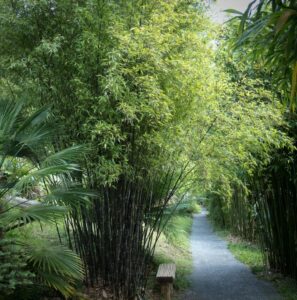
Offering a dramatic contrast to its golden counterpart, Phyllostachys Nigra boasts stunning black culms. This Asian native thrives in well-drained, fertile soil with moderate watering and prefers a position with full sun to partial shade.
Like Phyllostachys Aurea, root barrier installation is crucial for managing its spread. New South Wales, Queensland, Victoria, and even Tasmania offer suitable climates for this striking bamboo.
Australian Native Bamboos: A Touch of Local Flair
Beyond the popular Asian varieties, Australia boasts its own unique types of bamboo plants that add a touch of local character to your garden. Here’s why these unique plants deserve a spot in your backyard:
- Local Heritage: Unlike their Asian counterparts, Australian native bamboos have a rich history of thriving in the Australian climate. They’ve adapted to local conditions over millennia, perfectly suited to your garden’s specific environment.
- Sustainable Choice: Planting native species promotes biodiversity and supports the local ecosystem. Australian native bamboos provide habitat and food sources for native birds, butterflies, and insects, creating a haven for local wildlife.
- Low Maintenance: Having evolved in Australian soil, these native bamboos are naturally accustomed to the local climate and require minimal fuss. They often have lower water needs than some Asian varieties, making them a water-wise choice for your garden.
- Unique Beauty: Australian native bamboos offer a distinct aesthetic compared to their Asian relatives. Some varieties boast stunning foliage colors, while others showcase unique growth patterns. They add a touch of local character and a conversation starter to your garden design.
- Pest and Disease Resistance: Having co-evolved with local insects and diseases, Australian native bamboos tend to be more resistant to pests and diseases compared to some introduced varieties. This translates to less need for pesticides and a more natural approach to maintaining your bamboo haven.
By incorporating Australian native bamboo, you’re not just adding a beautiful plant to your garden; you’re contributing to the preservation of local biodiversity and embracing a unique aspect of Australian flora.
Bambusa Arnhemica (Northern Territory Bamboo)

Bambusa Arnhemica, a tall and sturdy bamboo variety, is a proud representative of the Australian flora, originating from the Northern Territory region. To thrive, it requires well-draining soil and moderate watering during the dry season. This plant flourishes in areas with full sun or partial shade, making it a versatile option for gardeners. However, given its natural habitat, Bambusa Arnhemica is best suited for the warm and humid climate of the Northern Territory, where it can reach its full potential.
Mullerochloa Moreheadiana (Cape York Bamboo)
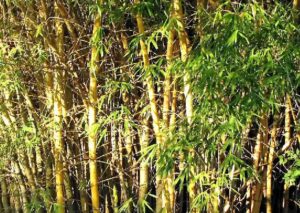
This stunning clumping bamboo is another gem native to Australia, specifically found in tropical regions like Queensland’s Cape York, Daintree, and Iron Range. It flourishes in well-drained, moist soil with regular watering, particularly during dry spells, and prefers a position with dappled sunlight to partial shade. Mullerochloa Moreheadiana thrives in the warm and humid climate of tropical Queensland.
Neololeba Atra (Black Bamboo)
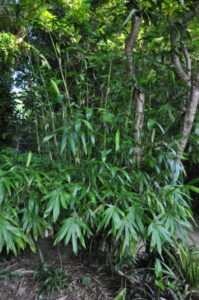
Don’t be fooled by the common name – Neololeba Atra is actually a dark green bamboo native to the wet tropics of Queensland, specifically the Daintree and Innisfail regions. This stunning bamboo prefers well-drained, moist soil with regular watering and thrives in a position with filtered sunlight to light shade. Due to its specific needs, Neololeba Atra is best suited for Queensland’s wet tropics’ warm and humid climate.
Beyond the Basics: Caring for Your Bamboo Paradise
Now that you’ve discovered the perfect types of bamboo plants for your garden, here are some essential care tips to ensure it thrives:
Watering
Watering is crucial for maintaining a thriving bamboo haven, but it’s important to strike the right balance to avoid harming your plants. Here’s a breakdown of watering needs for different scenarios:
-
Regular Watering: Most types of bamboo prefer regular water intake, especially during their active growth cycle (which is generally spring and summer). Water closely at the plant’s base, allowing the water into the root zone. The frequency of watering will be determined by the climate, soil type, and sunlight exposure.
-
Hot and Dry Spells: During long periods of heat and dryness, your bamboo requires frequent watering. Check the soil moisture on a regular basis by inserting your finger a few inches down. If the soil is dry to the touch, it is time to water.
-
Signs of Overwatering: Avoid overwatering, since this may lead to root rot. Overwatering creates yellowing leaves, wilting, and stunted growth. If you notice these signs, discontinue watering immediately and let the soil dry completely before resuming with a more moderate approach.
-
Mulching Matters: A layer of mulch around your bamboo plants helps maintain moisture in the soil, lowering the amount of watering needed. Organic mulch, such as bark chips or wood shavings, also helps minimize weeds and soil temperature.
Fertilizing
While bamboo isn’t as demanding as some plants when it comes to fertilizer, providing a balanced fertilizer a few times a year during the growing season can give your bamboo a boost. Here’s what you need to know:
-
Choosing the Right Fertilizer: Pick a balanced fertilizer designed for bamboo or ornamental grasses. These fertilizers usually have a lower nitrogen content compared fertilizers designed for flowering plants. Excessive nitrogen may stimulate leaf growth at the cost of a healthy root structure.
-
Frequency of Application: Generally, fertilizing your bamboo 2-3 times annually during the growing season is sufficient. Avoid fertilizing during the hottest days of the summer or during wintertime dormancy.
-
Organic Options: If you prefer a more natural approach, think about using organic fertilizers like composted manure or food scraps. These other options provide slow-release nutrients that boost the overall health of your soil.
Pest Control
Bamboo known as pest-resistant plant. However, it’s not entirely immune to common garden pests like aphids, scales, or mealybugs. Here’s how to maintain a healthy balance and keep pests at bay:
-
Early Detection is Key: Regularly inspect your bamboo for signs of pest infestation. Look for signs like yellowing leaves, sticky sap, or the presence of the insects themselves.
-
Natural Methods First: Whenever possible, opt for organic pest control methods. Introduce natural predators like ladybugs or lacewings to your garden, or try spraying the affected areas with a solution of insecticidal soap or neem oil.
-
Chemical Options as a Last Resort: If the infestation is severe and organic methods fail, consider using a horticultural insecticide specifically labeled for use on bamboo. Always follow the manufacturer’s instructions carefully when using any chemical product.
Conclusion
Determining the proper watering frequency can be a bit of a puzzle, but fear not! We just need to consider a few variables like the climate, type of soil, and how much sunlight your plants are getting. Once we have all the pieces in place, we’ll be able to give your green buddies the hydration they need to thrive!
FAQs
How fast does bamboo grow?
Bamboo is known for its rapid growth, with some varieties growing several feet per year.
Can I grow bamboo in a pot?
Yes, certain clumping bamboos can be grown successfully in pots, making them ideal for patios and balconies.
How do I control the spread of running bamboo?
A: Installing a root barrier around the planting area is crucial for managing the spread of running bamboos.
